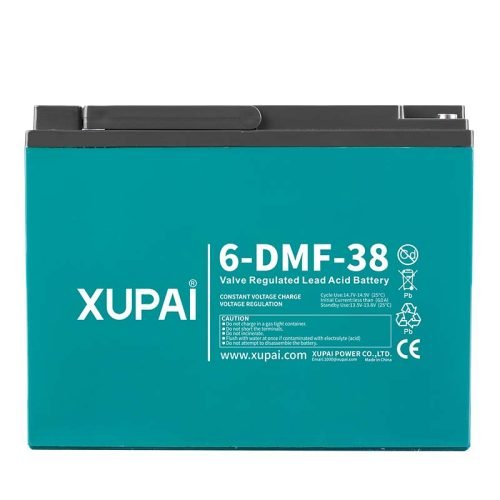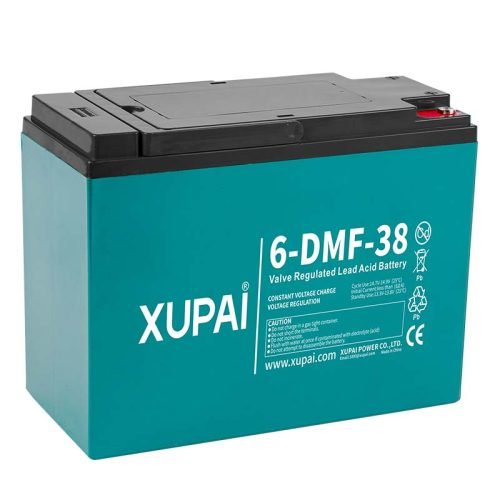The 12V 38Ah lead-acid power battery combines professional-grade performance with user-friendly reliability. Designed with deep-cycle technology, it delivers stable power for mobility scooters, wheelchairs, light EVs, and energy storage systems. Its maintenance-free AGM design ensures safety, durability, and resistance to vibration, making it ideal for both daily use and demanding applications. Easy to install and built for all-weather performance, this battery provides long service life and consistent energy output. Whether for personal mobility or industrial use, it offers a dependable, cost-effective solution—your trusted partner for continuous, worry-free power.


| Parameters | Details |
|---|---|
| Voltage (V) | 12 |
| 3hr Capacity (Ah) | 38 |
| Dimension (±2mm) (L×W×H×T/H mm) | 223 × 108 × 175 × 175 |
| Weight (Kg) | 11.4 ± 0.1 |
| Material of Shell | ABS |
| Max Resistance (mΩ) | 8.0 |
| Terminal | Copper (8.8-M5) |
| Operating Temperature Range | Discharge: -35°C ~ 50°C | Charge: -15°C ~ 40°C | Storage: -15°C ~ 40°C |
| Capacity ≥ (Ah, 25°C) | 3hr (12.67A to 10.5V): 38 5hr (7.6A to 10.5V): 41.1 10hr (3.80A to 10.5V): 43 20hr (1.90A to 10.5V): 45 |
| Self-discharge Rate (20°C) | >85% / 3 months |
| Charging Voltage (V) | Floating: 13.5V–13.8V Cycling: 14.4V–14.8V |
| Discharge Current (A) | 4.5 I3 |
| Charge Current (A) | 0.15 C3 |
| Residual Capacity After Self-discharge | 30 days: 90% 60 days: 85% 90 days: 82% 180 days: 80% |
| Discharge Time | Current (A, to 10.5V) | Capacity (Ah, 25°C) |
|---|---|---|
| 3 hr | 12.67 A | 38 Ah |
| 5 hr | 7.60 A | 41.1 Ah |
| 10 hr | 3.80 A | 43 Ah |
| 20 hr | 1.90 A | 45 Ah |
| Region | Brand | Model | Typical Battery Pack (Factory/Replacement) |
|---|---|---|---|
| Americas/Europe | Pride Mobility | Victory 9 (SC609) | 24V = 2×12V U1 35–38Ah (AGM/GEL) |
| Americas/Europe | Pride Mobility | Victory 10 (SC710) | 24V = 2×12V U1 35–38Ah |
| Americas/Europe | Pride Mobility | Victory ES 10 (S93/SC104) | 24V = 2×12V U1 35–38Ah |
| Americas/Europe | Pride Mobility | Sundancer (SC2000/SC202) | 24V = 2×12V U1 35–38Ah |
| Americas/Europe | Pride Mobility | Rally | 24V = 2×12V U1 35–38Ah |
| Americas/Europe | Pride Mobility (Power Chair) | Jazzy Air | 24V = 2×12V U1 35–38Ah |
| Americas/Europe | Pride Mobility (Power Chair) | Jazzy Elite ES-1 | 24V = 2×12V U1 35–38Ah |
| Europe | Invacare | Leo | 24V = 2×12V U1 35–38Ah |
| Europe/Americas | Invacare | Tri-Rolls (≤14”) | 24V = 2×12V U1 35–38Ah |
| Americas/Europe | Drive Medical | Gladiator GT | 24V = 2×12V U1 35–38Ah |
| Americas/Europe | Drive Medical | Image / Image GT | 24V = 2×12V U1 35–38Ah |
| SE Asia/Global | Shoprider | Flagship | 24V = 2×12V U1 35–38Ah |
| SE Asia/Global | Shoprider | Sunrunner 4 | 24V = 2×12V U1 35–38Ah |
| SE Asia/Global | Shoprider (Power Chair) | Streamer | 24V = 2×12V U1 35–38Ah |
| Europe (UK) | TGA Mobility | Zest Plus | 24V = 2×12V U1 35–38Ah |
| Europe (UK) | TGA Mobility | Sonet | 24V = 2×12V U1 35–38Ah |
| Europe (UK) | TGA Mobility | Vita Lite | 24V = 2×12V U1 35–38Ah |
| Europe/SE Asia | FreeRider | FR1 City | 24V = 2×12V U1 35–38Ah |
| SE Asia (Taiwan)/Global | Merits | Pioneer 4 (S141 series) | 24V = 2×12V U1 35–38Ah |
| SE Asia (Taiwan)/Global | Merits | Pioneer PT (S139/S149) | 24V = 2×12V U1 35–38Ah |
Always wear safety goggles, gloves, and protective clothing when handling or installing the battery.
Work in a well-ventilated area to avoid gas build-up.
When connecting, attach the positive terminal (red) first, then the negative terminal (black).
When disconnecting, do the reverse: negative off first, then positive.
Never connect the negative clamp to fuel lines, painted parts, or weak metal surfaces.
Check terminals regularly to ensure they are clean and tight. Wipe away dust or corrosion with a soft brush and baking soda solution.
For serviceable batteries, check electrolyte levels and top up with distilled water after charging if needed.
Use a quality 12V smart charger with automatic cut-off or pulse charging.
Follow recommended voltage: 13.5–13.8V (float use) and 14.4–14.8V (cyclic use).
Adjust for temperature: reduce charging voltage in hot weather, increase slightly in cold conditions.
Keep the battery in a ventilated space during charging.
If storing the battery, always keep it fully charged.
Recharge every 1–2 months to prevent sulfation and capacity loss.
Store in a cool, dry place away from direct sunlight and heat.
Stop using the battery if you notice swelling, overheating, leaking, or a big drop in performance.
Early action prevents bigger problems and keeps your equipment safe.
Mount the battery securely to avoid vibration or shaking, especially in vehicles or mobile equipment.
Ensure proper ventilation in the battery compartment to allow heat and gas to escape.
12‑month limited warranty against manufacturing defects. Technical support available for installation and charging best practices.
Our 12V 20Ah lead-acid battery is crafted with precision and care, using the latest technology and high-quality materials to provide unmatched performance for your electric vehicle. Power up your ride with confidence and enjoy the journey!
One year from the date of shipment



Tell us your application, voltage/capacity, target quantity, and delivery terms. Our team will reply within 24 hours.